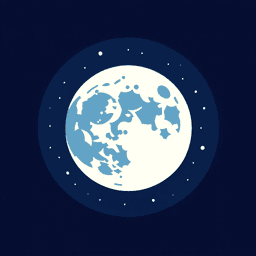
Full Moon: Definition, Phases, and Fascinating Facts
February 27, 2025
Full Moon
The full moon is a lunar phase that occurs when the Moon is on the opposite side of the Earth from the Sun, resulting in the entire face of the Moon being illuminated. This phase is significant in maritime contexts for several reasons:
- Tidal Influence: The full moon is associated with spring tides, which are higher than average tides. These tides occur because the gravitational forces of the Moon and the Sun align, pulling the ocean's water in the same direction. Sailors need to be aware of these tides as they can affect navigation and anchorage.
- Visibility at Sea: A full moon provides increased natural light at night, which can be beneficial for navigation and spotting hazards. This enhanced visibility can be particularly useful in areas without artificial lighting.
- Weather Patterns: Some sailors believe that the full moon can influence weather patterns, although scientific evidence is limited. Nonetheless, understanding lunar phases can be part of traditional maritime knowledge.
- Navigation and Folklore: Historically, sailors have used the full moon for celestial navigation. Additionally, maritime folklore often includes tales and superstitions related to the full moon, which can be an interesting aspect of cultural heritage at sea.
Overall, the full moon is an important consideration for sailors, affecting tides, visibility, and potentially weather, all of which are crucial for safe and effective maritime operations.
Understanding the Full Moon in Maritime Context
The full moon has long been a significant phenomenon in maritime traditions and practices. For seafarers, the full moon is not just a beautiful sight but also a crucial element that influences navigation, fishing, and safety at sea.
How Does the Full Moon Affect Tides?
The full moon plays a pivotal role in the tidal patterns experienced by maritime users. During a full moon, the gravitational pull of the moon and the sun align, leading to what is known as "spring tides." These tides are characterized by higher high tides and lower low tides, which can significantly impact navigation and docking procedures for ships.
Why is the Full Moon Important for Fishing?
Many maritime communities rely on the full moon to optimize their fishing activities. The increased light during a full moon night can attract certain species of fish to the surface, making them easier to catch. Additionally, the spring tides associated with a full moon can lead to increased fish activity, providing better opportunities for a successful catch.
Does the Full Moon Affect Weather at Sea?
While the full moon itself does not directly affect weather patterns, it can influence certain atmospheric conditions. The increased gravitational pull during a full moon can lead to changes in wind patterns and ocean currents, which may affect weather conditions experienced by maritime users.
Are There Any Superstitions Related to the Full Moon in Maritime Culture?
Throughout history, the full moon has been surrounded by various superstitions in maritime culture. Some sailors believe that a full moon can bring good luck and favorable winds, while others are wary of its potential to stir up storms and rough seas. These beliefs, while not scientifically proven, continue to be a part of maritime folklore.
In conclusion, the full moon holds significant importance in maritime activities, influencing tides, fishing, and even cultural beliefs. Understanding its effects can help maritime users better prepare and adapt to the conditions at sea.




